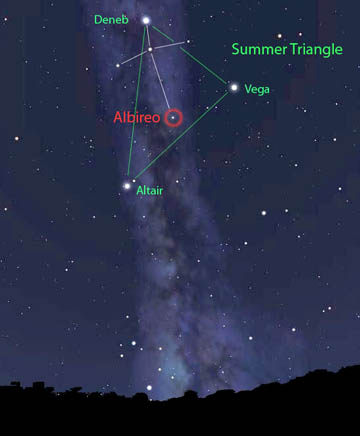
The Planets this Week: The highlight of the planets this week is no doubt Saturn. It reaches opposition early Monday morning and will appear it’s brightest in the sky. To the naked eye it won’t appear much brighter than other times during the month but through a telescope the rings will appear noticeably brighter around this time thanks to the Earth sitting precisely between Saturn and the Sun. Jupiter remains just to the east of Saturn rising about an hour later. Venus shines very brightly in the evening sky and Mars sits below it significantly dimmer. Venus appears noticeably not-quite-round in a telescope at around 82% illumination this week.
Naked Eye Object of the Week- Albireo: This week’s naked eye object is another famous star: Albireo. Albireo is located in the constellation Cygnus and is currently high in the sky at sunset and directly overhead by 11PM. To the naked eye it appears as a 3rd magnitude star but just a small amount of magnification reveals a surprise: it’s actually two stars! It is actually one of the more impressive double stars when seen at magnification appearing with a big color contrast between a large yellow star and a smaller blue one. No one is quite sure whether the stars are actually orbiting each other or just appear this close together (an optical double), but if they are orbiting one another it must take a least 100,000 years. This is much different than many of the definite true binary systems.

The larger star is known as Beta Cygni A and the smaller as Beta Cygni B. The name Albireo is actually a result of some mistranslations throughout the years. No one is quite sure how it happened but through a series of mis-copies and translations the name Eyrsimon (a hedge mustard) which is called ireo in Latin. Whatever happened, this pair of stars is certainly a sight to see. You can find them straight overhead around 11PM local right now in the constellation Cygnus inside the Summer Triangle we talked about last week.

Telescope Object of the Week-M11: One of my personal favorite objects in the night sky is our telescope object this week. M11, or the Wild Duck Cluster, is an open star cluster located in the constellation Scutum. It was discovered by Gottfried Kirch in 1681 and first catalogued by Charles Messier. It gets it’s common name from the roughly V shaped pattern of brightest stars.

M11 is one of the most heavily studied open clusters. It is also one of the most large and compact as it is estimated to contain at least 2900 stars. An open cluster is a cluster of stars that is very loosely bound by gravity after all forming from the same molecular cloud. Unlike their significantly more compact cousins globular clusters, they are slowly torn apart by close encounters with other wandering clouds and stars. M11 is also quite young clocking in at roughly only 316 million years old, much younger than even the Earth. It is easily visible through binoculars as a small hazy patch but magnification with a telescope reveals it’s true beauty as you are staring at thousands of stars. The moonless evenings this week will make for excellent viewing conditions of this cluster.

Get out and enjoy the stars this week. Hopefully the weather gives us some great star gazing conditions.
As always, watch the skies!







